A study by the Group for Advanced Receiver Development (GARD, Sweden) to develop new fabrication technology for sub-micron size Aluminium Nitride (AlN) barrier Superconductor Insulator Superconductor (SIS) junctions has been successfully completed. These SIS junctions are at the core of most ALMA receivers where the sky signal is mixed with the Local Oscillator to tune the receivers to the desired frequency.
Completion of the study on AlN SIS junctions technology development

Left: SEM image of an SIS junction pattern. Right: Current-Voltage curve of a newly produced Band 9 junction
For the ALMA Wideband Sensitivity Upgrade, upgrading these junctions is critical to extend the instantaneous frequency coverage. This requires reducing their area to sub-micron size and to use AlN barrier, which will achieve lower specific capacitance of the junctions compared to the standard Aluminum Oxide barrier junctions without compromising their quality. The potential was demonstrated to achieve down to 0.5µm2 area for the practical SIS junctions.
The study concentrated on the development of AlN SIS technology and has been applied to producing a Band 9 demonstrator SIS chip, based on a design made by the Nederlandse Onderzoeksschool Voor Astronomie (NOVA, the Netherlands). New junctions with sizes of 0.8 µm2 were produced (see Figure), with the first few junctions performing comparable to or better than the best Band 9 receivers currently installed at ALMA. Additionally, the same developed SIS process served another ESO study with SIS mixer devices for Band 6/7 frequency range and the first results have also shown the suitability and usefulness of the developed process.
Overall, the updated SIS fabrication process proves its suitability and advantage for use in the coming ALMA receiver upgrades.

